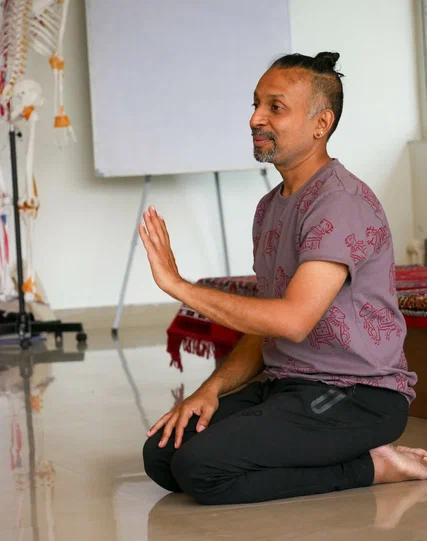In the world of yoga, Dhanurasana, commonly known as Bow Pose, is a powerful and invigorating posture. This backbend is not only physically pleasing but also offers some health benefits for the body, mind and spirit. Today, we will delve into the various advantages of performing Dhanurasana into your daily yoga practice and we will know how it will unlock your potential to enhance physical flexibility, mental well-being and overall vitality.
The benefits of dhanurasana are divided into three parts:
1. Physical Benefit
2. Mental and Emotional Benefits
3. Energetic and Spiritual Benefits
Below we have explained different aspects of these benefits which will encourage you to indulge in this activity.
Physical Benefits of Dhanurasana
1. Spinal Flexibility and Strength: Dhanurasana is a dynamic backbend, in this pose, the entire length of the spine is engaged. As you lift both the upper and lower body off the ground, the spine undergoes a deep stretch, using complete flexibility and mobility. With this, the muscles of the spine, including the erector spinae, are strengthened, which leads to better body posture and spinal health.
2. Stimulates the Digestive Organs: The expansion and compression of the abdomen during Dhanurasana, massages the digestive organs from inside, it improves digestion of your body. Individuals who are suffering from discomfort and digestive issues, dhanurasana can be particularly beneficial for them. The asana helps in the detoxification process by enhancing the functioning of organs like the pancreas and liver.
3. Tones and Strengthens Muscles: Bow Pose or dhanurasana is not only a yoga pose, but a full body workout, targeting various muscle groups in the same time. The muscles of the back, legs, abdomen and arms are actively engaged simultaneously, promoting overall muscle tone and strength. Regular practice of Dhanurasana contributes to the development of improved muscular endurance and lean muscle mass.
4. Enhances Respiratory Function: The expansive chest opening in Dhanurasana facilitates deep breathing, improving respiratory efficiency and increasing lung capacity. The posture encourages diaphragmatic breathing, which is especially beneficial for individuals dealing with asthma.
5. Stimulates the Cardiovascular System: it is also a beneficial exercise for cardiovascular system. With the combination of increased circulation and deep breathing while performing Dhanurasana, provides a cardiovascular workout. Contributing to improved healthy heart by enhancing blood circulation and the supply of oxygen and nutrients in the body.
6. Relieves Lower Back Pain: People dealing with back pain issues are specially advised to do dhanurasana regularly. While dhanurasana, the posture and stretch alleviate tension and promotes flexibility.
Mental and Emotional Benefits of Dhanurasana
1. Elevates Mood and Alleviates Stress: Backbends in yoga, are associated with mood enhancement. The physical act of opening the chest region is believed to release tension and stress and elevates the mood.
2. Promotes Concentration and Focus: People who are not able to focus, run towards yoga. There are many asanas that help you in strengthen your fucus and dhanurasana is one of those asanas. Regular incorporation of this pose can contribute to improved concentration in daily life.
3. Eases Anxiety and Fatigue: In dhanurasana, body is expanded to its limit, due to this nature, Dhanurasana encourages deep breathing, activating your parasympathetic nervous system. The asana is also known for its fatigue-fighting properties, making it an excellent addition to your routine.
Energetic and Spiritual Benefits of Dhanurasana
1. Stimulates Manipura Chakra: In yogic philosophy, the Manipura Chakra, located in the solar plexus in your body, is source of personal power such as confidence, and transformation. The bow shape of Dhanurasana energetically activates and balances the Manipura Chakra.
2. Opens the Heart Chakra: The heart-opening aspect of Dhanurasana is for Anahata Chakra, also called the Heart Chakra. Anahata chakra is energy center of your body and is associated with love, compassion and emotional aspects. The practice of Bow Pose encourages a sense of openness.
Tips for Practicing Dhanurasana Safely
1. Warm-Up Adequately: Before attempting Dhanurasana, ensure your body is warmed up enough. Start with the gentle stretches, especially for the spine, thighs and shoulders to prepare your body for the deeper backbend. As deep you will go, as more beneficial it will be for you.
2. Modify as Needed: If you are a beginner or have existing health concerns such as back pain, consider using props or modifying the pose. For example, you can use a yoga strap to reach your ankles or practice a half Bow Pose to build the flexibility and strength gradually. As deep you will go, as more beneficial it will be for you.
3. Listen to Your Body: You need to pay a close attention to how your body responds to the pose. If you experience pain the lower back or problem in maintaining the pose, release the pose immediately. Consult with a yoga instructor or healthcare professional.
4. Breathe Mindfully: Avoid holding your breath, and allow the breath to guide and support your movements.
Dhanurasana, the Bow Pose, is a multifunctioned yogic asana that has benefits beyond physical flexibility. As soon as you add this pose into your practice, you move forward on a journey of holistic well being, nurturing your body, aligning your energy centers and calming your mind.
Whether you are seeking relief from lower back pain, a mood boost or a spiritual connection, Dhanurasana invites you to bow to the harmony of mind and body. It is a way to foster a balanced and vibrant life. As with any yoga practice, approach Dhanurasana with mindfulness, respect for your body’s limitations and a sense of joy in the journey of self-discovery.
Connect with us

